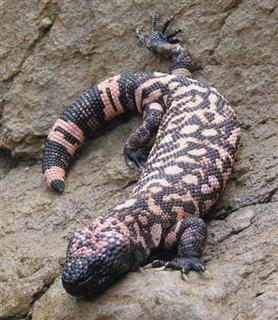Gila Monster
Reticulate Gila Monster Scientific Name: Helodermus suspectum
Sat, 5th July, 2025 - 7:33 pm GMT
Sponsor Ads:

Alternative Name
Reticulate Gila Monster Scientific Name: Helodermus suspectumBasic Info
A full grown Gila Monster measures between 18 and 24 inches and has a very thick tail, especially at the base. Its face is black, but the rest of the lizard is beautifully colored with pink, yellow, orange, or red accents over bead-like, rounded scales. The color is seen as bands, spots, or blotches over the basic black coloration and may extend onto the tail. Usually the tail has thick black bands. The Gila Monster's teeth have grooves that help to conduct the poison that it exudes from its lower jaw into the item it bites, through capillary action. The Gila Monster's body is compact and powerful. The head is blunt and the legs are short, and the lower jaw is very strong.
Health
While not an aggressive lizard, the Gila Monster may bite if startled or handled, and because it is potentially dangerous, should only be kept by the most experienced reptile keepers and herpetologists. In captivity, Gila Monsters may be kept in large enclosures allowing between three and three and a half square feet for an adult. They will need a substrate temperature between 85 and 90 degree Fahrenheit on one side of the cage. Mice or baby rats may be offered every week or every two weeks, and a bowl of fresh water should be available to the Gila Monster at all times. These animals may eat to the point of obesity and have very slow metabolisms, so it will be up to you to carefully monitor your lizard's diet. Breeding Gila Monsters will generally mate each year or every other year. They are sexed using an ultrasound. Males tend to have broader heads than females, and females may have more pear-shaped bodies, but visually sexing this type of lizard has proved inconsistent and difficult in the past. Gila Monsters will need to be hibernated from November to March if you plan on breeding them. After hibernation, males will fight other males and should be kept absolutely separate until after mating. After mating, females will also fight and should be separated. Each will need a nest box with a damp sphagnum moss substrate. Gravid females will eat although their tail will thin while its fat stores are depleted. Usually, they will shed a few weeks before they lay. The clutch size depends upon the size of the Gila Monster - 2 to 13 eggs may be deposited in the nest box. Usually, Gila Monster eggs do well when incubated in a 1:1 to 1:4 water/vermiculite mixture. Usually, it is better to err on the drier side than the moist side. The temperature should be between 79 to 82 degrees Fahrenheit. After 124 to 140 days, the eggs will hatch. In the wild, eggs laid in summer will hatch the following spring.Habitat
Found in the deserts of northern Mexico and the southwestern United StatesBehavior
One of only two species of venomous lizards, the beautiful Gila Monster an extremely effective defense mechanism. Gila Monsters hide in the shade by day, under rocks or in burrows, which they dig or take over from other animals. During the winter, the Gila Monster does not have to eat; rather, it lives off the fat it has stored in its tail during the warmer months. When food is available, a Gila Monster can eat a third of its weight in one sitting. There are theories suggesting that because of the Gila Monster's fat storage system, it may consume enough energy for the year in three or four of these very large meals. If it feels threatened, the Gila Monster will bite its perceived aggressor. They have a locking bite and are very difficult to remove. In addition, the Gila Monster is venomous! This proves deadly to most animals, although rarely would the poison kill a healthy human adult, being envenomated by a Gila Monster will cause significant tissue damage and is reportedly extremely painful. Gila Monster will only bite when provoked; as a rule, they tend to be quite sluggish. These lizards are most active early in the morning. They do not like to leave their burrows frequently and will remain in their homes all winter. Gila Monsters live about 20 years on average. Although they are usually solitary and have home territories of about one square mile, Gila Monsters will congregate in common areas for mating in the spring.Origin
Southwest United StatesHistory
Gila Monsters are found in the deserts of northern Mexico and the southwestern United States. The Gila Monster receives its name from the Gila River Basin in the United States where it may be commonly found. In the lore of many local peoples, the Gila Monster possesses magical powers and is the subject of myths. Today, the Gila Monster is threatened due to habitat loss and capture for the pet trade.Common Foods
They eat mainly small mammals, birds, and bird eggs.Sponsor Ads:
"I never let my schooling get in the way of my education." -- Mark Twain
Gila Monster
Coded by: BGID® | ALL RIGHTS RESERVED Copyright © 2000-2025
Disclaimer | Privacy | Report Errors / Contact | Credits

 Preparing For China. China is growing their military. China Military Technology - can it keep up with the US?
Preparing For China. China is growing their military. China Military Technology - can it keep up with the US?  versus
versus 

 versus
versus 
 This Thread is about the North Korean Military itself - the kind of army, navy, and air force they have.
This Thread is about the North Korean Military itself - the kind of army, navy, and air force they have. 
 versus
versus 
 versus
versus  versus
versus